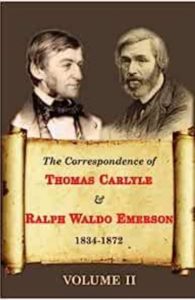
I had planned to write a post today about the pastoral change our church is going through, but I think I’m going to wait until Friday for that. So here’s a book review, of the book The Correspondence of Thomas Carlyle and Ralph Waldo Emerson.
I first read this during the early 2000s, having found it on Project Gutenberg, downloaded both volumes, formatted them for a good mix of easy reading and concise printing, and printed them. I read them rather quickly, my second foray into the world of letter collections after the letters of Charles Lamb. Recently I learned that you can upload a Word file to Kindle. I did so with these two volumes and read them again on my phone.
At that time, Carlyle I was just beginning to know, and Emerson was a total mystery to me. Neither man had been part of the curriculum in my school years, and my adult reading up to that point had been in different directions. Why I happened upon these volumes, why I downloaded and formatted them, and why I shoved other reading aside for them are all mysteries to me.
But read them I did, and loved them. These two literary giants, from opposite sides of the Atlantic, both influential in their milieu, both men who enjoyed friendship. Carlyle was probably the more brusque of the two, Emerson the more gentle. They divided over politics, including the question of slavery. Hard to believe in this day, but Carlyle was pro-slavery, and this became a wedge between them.
Yet the friendship endured. Emerson, who had both inherited ad married into money in America, took note of Carlyle’s poverty and became his promoter in the New World, where he thought Carlyle would find an audience. He found publishers and negotiated deals favorable to Carlyle. Soon, dollars were sent eastward to be converted into pounds, and Carlye could soon say he was not poor any more. Implied was he was now free to write what he wanted rather than to write for money.
The friends met during Emerson’s three trips to Europe. The first time, in 1833, Emerson (who was totally unknown to Carlyle) sought out Carlyle, whose magazine articles Emerson had taken special note of. They had a 24-hour visit before Emerson left for the return voyage. But the conversation was stimulating. Eight months later, Emeron wrote to Carlyle, and the forty years of letters commenced.
The letters are rich in the words of friendship. They discussed their writings, their homes, their families, their lives. At one point, Emerson pulled back from immediately returning Carlyle’s letters, at least in part due to the rift over politics. The correspondence never ended, but it tapered off. The first twenty years include at least twice the number of letters than the last twenty.
The Emerson quote I include on my website comes from one of his letters to Carlyle. In this, my second reading of the letters, I found great enjoyment. I suspect someday I will read them again.